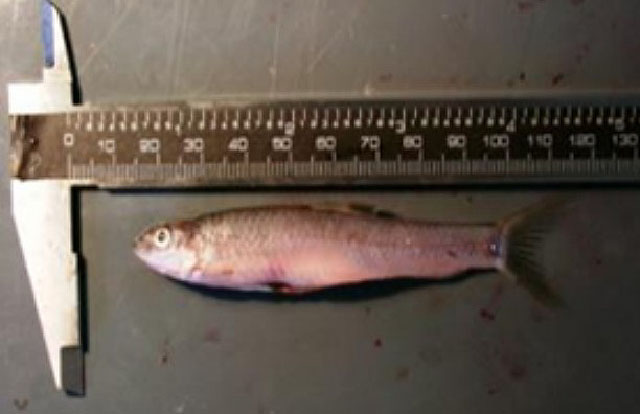|
Dorsal spines (total): 0-0; Dorsal soft rays (total): 10-10; Anal spines: 0-0; Anal soft rays: 8-8. Diagnosis: This species is unique among African Garra in possession of a small, acutely pointed head, narrow mouth, regressed rostral cap, and a fully exposed upper jaw (Ref. 58532).
Description: Garra regressus is relatively slender and elongate, greatest body depth located at level of dorsal-fin origin; head relatively short, being 19.7-21.0% of standard length; snout acutely pointed and often studded with small tubercles, mouth narrow; eye positioned a little posterior on head (Ref. 58532). Dorsal head profile rising steeply over snout, dorsum of head more-or-less flatened, dorsal body profile smoothly convex to dorsal-fin origin (Ref. 58532). Disc weakly developed and inconspicuous, without free posterior margin; rostral cap thin and regressed leaving upper jaw exposed (Ref. 58532). Two pairs of small barbels, maxillary pair usually longest (Ref. 58532). Number of pored scales along lateral line 39; either 8 or 9 predorsal scales anterior to dorsal fin; either 3-4 scales from lateral line to origin of pelvic fin; either 4-5 scales from lateral line to origin of dorsal fin; chest asquamate, belly with a few deeply embedded scales, and postpelvic region fully scaled (Ref. 58532). Dorsal fin with iii,7 rays, inserted well anterior to pelvic fin, with short acuminate tip, first and second branched rays longest; anal fin with iii,5 rays, with short subacuminate tip; pectoral fin with iv,11 rays, its length 17.5-21.0% of standard length (Ref. 58532). Predorsal length 44.0-46.3% of standard length (Ref. 58532). Vent located relatively close to anal fin (Ref. 58532).
Colouration: Body dark brown dorsally, somewhat lighter brown below lateral line but not markedly so; in largest specimen traces of a dark midlateral band evident (Ref. 58532). Head, snout, cheek and opercle dark brown; lips, lower cheek, gular region and branchiostegal membranes pale yellow brown (Ref. 58532). Dorsal and anal fins dark brown distally, paler proximally, with pale, creamy subacuminate tips; either 4 or 5 discrete black spots between rays in basal membrane of dorsal fin; caudal fin uniformly dark brown; pelvic and pectoral fins light brown with pale leading edges (Ref. 58532). |

